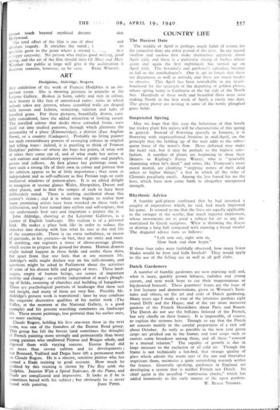ART
Hodgkins, Aldridge, Rogers
ANY exhibition of the work of Frances Hodgkins is an im- portant event. She is showing pictures in gouache at the Lefevre Gallery. Broken in form, subtle and rich in colour, their beauty is like that of unrestored ruins: ruins in which nobody takes any interest, whose crumbled walls are draped with mosses and lichens, stonecrop, valerian and tufts of tasselled grass. For these pictures, beautifully drawn, care- fully considered, have the added attraction of looking casual. The jewelled colour that decks these corroded forms sorts itself out into studied patterns, through which glimmers the personality of a place (Kimmeridge), a district (East Anglian Farm), or a country (Cadaques). Probably no living painter has such extraordinary powers of arranging colours in original and telling ways: indeed, it is puzzling to think of Frances Hodgkins' palette—of where she buys her paints, of what sort of tubes they come out of, and of what made her arrive at such curious and satisfactory appositions of pinks and purples, greens and yellows. At first glance her paintings seem to have such a strong life of their own in colour and pattern that the subjects appear to be of little importance ; they seem as independent and as self-sufficient as fine Persian rugs or early mediaeval windows of pattern-glass. It is an added delight to recognise at second glance Wales, Shropshire, Dorset and other places, and to find the temper of each to have been deliberately noted. There is nothing accidental about this painter's vision ; and it is when one begins to realise how many promising artists have been wrecked on these reefs of deliberation, and have turned into stylists and self-copiers, that one understands how rare and important a painter she is.
John Aldridge, showing at the Leicester Galleries, is a painter of English landscape. His realism is of a personal kind. He makes a place look like in order to seduce the onlooker into sharing with him what he sees as the real life of the countryside. There is no extra turbulence, or excess of quietude, in his pictures—in fact, they are strict and exact. If anything, one registers a sense of above-average gloom, which seems to prepare the ground for drama. Human dramas might indeed happen in these fields and under these skies, but apart from that one feels that at any moment Mr. Aldridge's mills might declare war on his mill-streams, and questions might be asked in Parliament about the activities of some of his distant lulls and groups of trees. These land- scapes, empty of human beings, are scenes of important activity and change : an activity independent of man's plough- ing of fields, restoring of churches and building of bungalows. These are psychological portraits of landscape that show tact and insight, and many of them are very fine. Possibly Mr. Aldridge's present work is transitional : later he may combine the exquisite decorative qualities of his earlier work (The Valley, at the moment at the National Gallery, is a good example) and his present searching comments on landscape life. These recent paintings, less pictorial than his earlier ones, are more exciting.
Claude Rogers, holding his first one-man show in the next room, was one of the founders of the Euston Road group. This group has felt the breeze (and sometimes the draught). of French painting more strongly and permanently than many young painters who swallowed Picasso and Braque whole, and digested them with varying success. Euston Road did no more than savour cubism and its developments ; but Bonnard, Vuillard and Degas have left a permanent mark on Claude Rogers. He is a sincere, sensitive painter who has turned a Slade training to good account. How much he profited by this training is shown by The Boy with the Dolphin. Interior With a Spiral Staircase, At the Piano, and Nude are complicated and impressive. It looks as if he is sometimes bored with his subject ; but obviously he is never










































 Previous page
Previous page